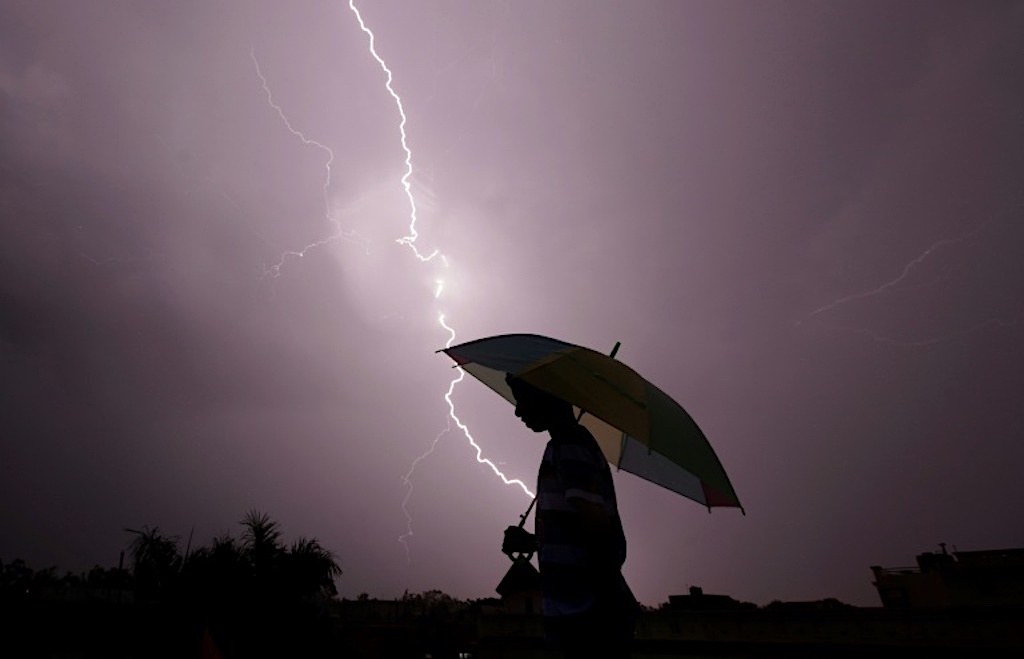Science
Scientists Use Lasers to Decode Lightning’s Mysterious Spark

Researchers from Austria have developed a groundbreaking technique using laser beams to study how a single aerosol particle charges up, which could provide insights into the origins of lightning. By deploying two precisely aligned laser beams, the scientists can hold an aerosol particle in place, allowing them to monitor its electrical state and observe how it loses and gains charge. This innovative approach offers a glimpse into the processes that may be occurring within storm clouds, potentially shedding light on how lightning is initiated.
Aerosols are tiny droplets or solid particles that exist in the atmosphere, ranging from visible entities like pollen to microscopic particles, including viruses. In their recent study, the researchers focused on understanding the behavior of ice crystals that form in clouds. To investigate how these crystals accumulate charge, they modeled aerosols using small, transparent silica spheres, enhancing their ability to observe charging processes.
The process involves using optical tweezers, which trap and stabilize a single silica particle through intersecting laser beams. When the beams converge, they create a concentrated point of light that can hold the particle in place. This setup allows scientists to study how the particle charges up and releases charge bursts, mirroring possible behaviors of particles in thunderstorm clouds.
During the experiments, a significant discovery was made regarding how particles gain charge. The researchers identified a process called the “two-photon process,” wherein two photons strike the particle simultaneously, leading to the ejection of a single electron. This loss of an electron results in a net positive charge for the particle, and with continued exposure to laser light, the particle becomes increasingly charged. The researchers can adjust the laser power to control the rate at which the particle charges, revealing a dynamic process of charge accumulation and loss.
As the particle charges up, it also experiences sudden discharges that may reflect natural phenomena occurring in the atmosphere. Within thunderstorm clouds, particles such as ice crystals collide and transfer electrical charges over time. This process can lead to a significant electrical imbalance, ultimately resulting in lightning formation. It is hypothesized that the initial spark of a lightning bolt may originate from charged ice crystals, although the exact mechanism behind lightning remains an area of ongoing research.
The findings of this study highlight that the electric fields within clouds might not be strong enough to trigger lightning by themselves. Instead, the interactions between particles, such as those observed in the laboratory, could play a crucial role in understanding how lightning is generated.
This research has been published in the journal Physical Review Letters under the title “Using Optical Tweezers to Simultaneously Trap, Charge, and Measure the Charge of a Microparticle in Air.” The study marks a significant advancement in the field of atmospheric science, providing a new method for investigating the complex processes that lead to lightning and enhancing our understanding of weather phenomena.
-

 Politics3 weeks ago
Politics3 weeks agoSecwepemc First Nation Seeks Aboriginal Title Over Kamloops Area
-

 World4 months ago
World4 months agoScientists Unearth Ancient Antarctic Ice to Unlock Climate Secrets
-

 Entertainment5 months ago
Entertainment5 months agoTrump and McCormick to Announce $70 Billion Energy Investments
-

 Lifestyle4 months ago
Lifestyle4 months agoTransLink Launches Food Truck Program to Boost Revenue in Vancouver
-

 Science5 months ago
Science5 months agoFour Astronauts Return to Earth After International Space Station Mission
-

 Technology3 months ago
Technology3 months agoApple Notes Enhances Functionality with Markdown Support in macOS 26
-

 Top Stories2 months ago
Top Stories2 months agoUrgent Update: Fatal Crash on Highway 99 Claims Life of Pitt Meadows Man
-

 Lifestyle3 months ago
Lifestyle3 months agoManitoba’s Burger Champion Shines Again Amid Dining Innovations
-

 Politics4 months ago
Politics4 months agoUkrainian Tennis Star Elina Svitolina Faces Death Threats Online
-

 Sports5 months ago
Sports5 months agoSearch Underway for Missing Hunter Amid Hokkaido Bear Emergency
-

 Politics4 months ago
Politics4 months agoCarney Engages First Nations Leaders at Development Law Summit
-

 Technology5 months ago
Technology5 months agoFrosthaven Launches Early Access on July 31, 2025





















